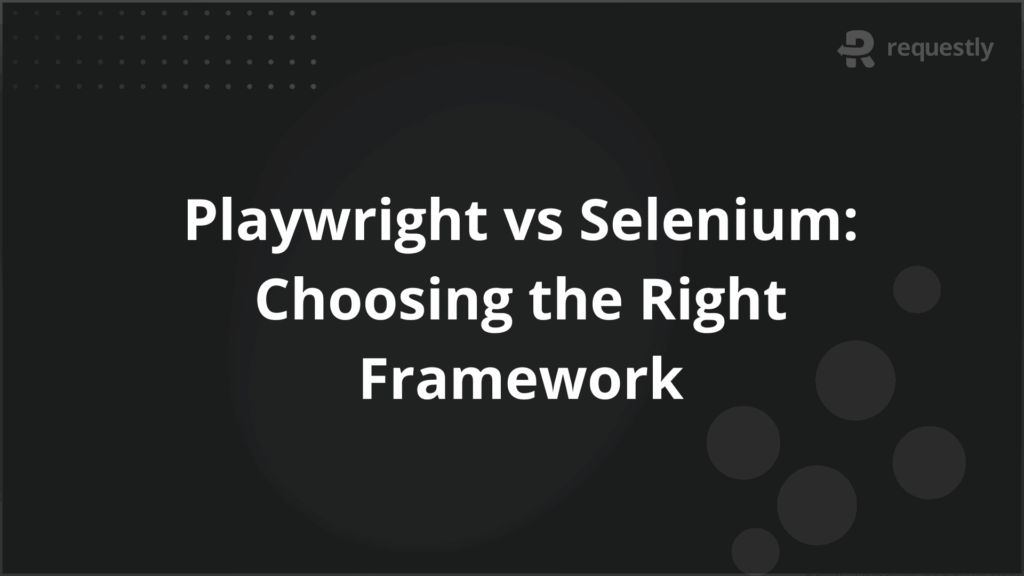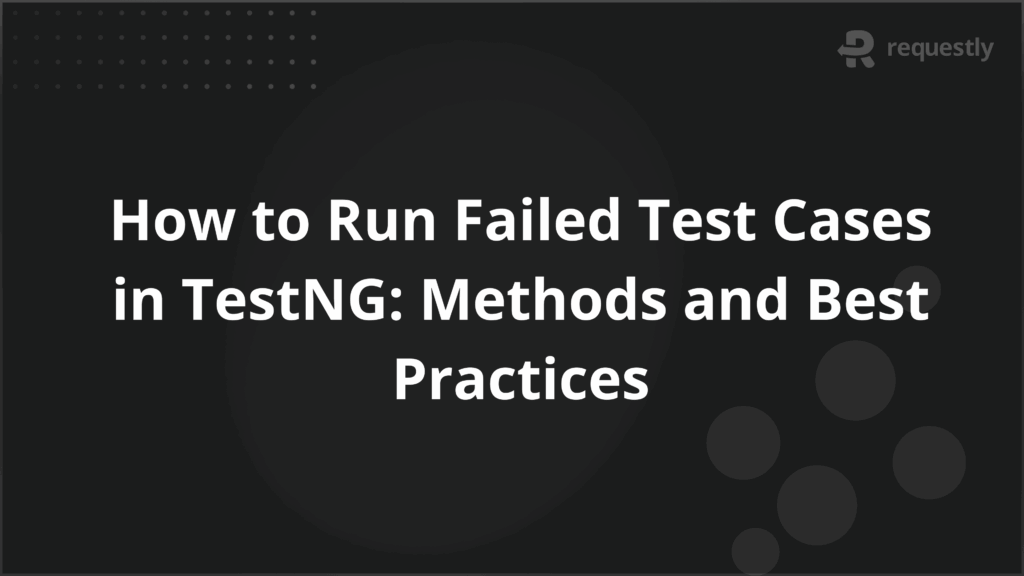Playwright vs Selenium: Choosing the Right Framework


Automated testing has become a cornerstone of delivering high-quality web applications in fast-paced development cycles. Among the most widely adopted tools for browser automation are Selenium and Playwright. Both enable teams to validate user flows, check compatibility across browsers, and accelerate regression testing.
However, while Selenium has been the industry standard for over a decade, Playwright is a relatively new entrant that has gained rapid adoption due to its modern architecture and developer-friendly APIs.
Choosing Between Playwright and Selenium
- Selenium is best for multi-language projects, legacy browser support (including IE), and mature integrations like Selenium Grid.
- Playwright is ideal for modern web apps, offering auto-waiting, network mocking, and faster local execution with parallelism.
Understanding the similarities, differences, and strengths of each tool helps engineering teams select the right framework for their test automation strategy.
Overview of Playwright and Selenium
Although both Playwright and Selenium are designed for browser automation, they differ in architecture, ecosystem, and intended use cases.
- Selenium was first released in 2004 and has since become the de facto standard for web UI automation. It provides bindings for multiple programming languages and works across all major browsers. Selenium’s long-standing ecosystem includes support for parallel execution, integration with popular CI/CD tools, and a large contributor base.
- Playwright, developed by Microsoft in 2019, builds on lessons learned from tools like Puppeteer. It provides modern capabilities such as auto-waiting for elements, cross-browser context handling, and advanced features for testing single-page applications (SPAs). Playwright supports JavaScript, TypeScript, Python, Java, and .NET, appealing to a wide developer audience.
Understanding Playwright
Playwright was designed with modern web applications in mind, particularly those built with dynamic frameworks like React, Angular, or Vue.
Key Characteristics of Playwright:
- Multi-browser support: Works with Chromium, Firefox, and WebKit engines.
- Auto-waiting mechanism: Eliminates the need for manual sleep or wait commands by waiting for elements to become actionable.
- Network interception: Allows simulation of offline states, blocking requests, or mocking APIs for controlled testing.
- Browser contexts: Enables running multiple independent sessions within a single instance, improving performance in parallel testing.
- Headless and headed modes: Tests can run invisibly in headless mode or visibly in headed mode for debugging.
Sample Playwright test in Python:
from playwright.sync_api import sync_playwright
with sync_playwright() as p:
browser = p.chromium.launch(headless=False)
page = browser.new_page()
page.goto("https://example.com")
page.fill("input[name='q']", "Playwright Python")
page.click("text=Search")
assert "Results" in page.title()
browser.close()
This demonstrates Playwright’s concise API for navigation, interaction, and validation.
Understanding Selenium
Selenium is one of the most mature automation frameworks, with wide adoption across enterprises. Its strength lies in versatility and extensive ecosystem support.
Key Characteristics of Selenium:
- Multi-language support: Works with Java, Python, C#, Ruby, JavaScript, and more.
- Cross-browser compatibility: Supports Chrome, Firefox, Edge, Safari, and Internet Explorer.
- Grid execution: Enables distributed and parallel testing across multiple machines and environments.
- Integration ecosystem: Works seamlessly with frameworks like TestNG, JUnit, and pytest, as well as CI/CD tools like Jenkins and GitHub Actions.
- W3C WebDriver protocol: Standardized way to communicate with browsers, ensuring reliability and future compatibility.
Sample Selenium test in Python:
from selenium import webdriver
from selenium.webdriver.common.by import By
driver = webdriver.Chrome()
driver.get("https://example.com")
search_box = driver.find_element(By.NAME, "q")
search_box.send_keys("Selenium Python")
search_box.submit()
assert "Selenium Python" in driver.title
driver.quit()
Although more verbose than Playwright, Selenium remains highly flexible and well-suited for enterprise-scale projects.
Playwright vs Selenium: Detailed Comparison
While both tools enable browser automation, their differences shape which one may be the better fit in specific contexts.
1. Language and Framework Support
- Selenium: Supports almost every major programming language.
- Playwright: Primarily JavaScript/TypeScript, but also Python, Java, and .NET.
2. Browser Coverage
- Selenium: Supports Chrome, Firefox, Edge, Safari, and legacy Internet Explorer.
- Playwright: Covers Chromium, Firefox, and WebKit (Safari engine), ensuring cross-platform parity.
3. Wait Mechanisms
- Selenium: Requires explicit waits (WebDriverWait) or implicit waits. Misuse often leads to flaky tests.
- Playwright: Built-in auto-waiting reduces flakiness and eliminates the need for most explicit waits.
4. Parallelism and Test Speed
- Selenium: Relies on Selenium Grid or third-party tools for parallel execution.
- Playwright: Uses browser contexts for lightweight parallelism, faster in local environments.
5. Ecosystem and Integrations
- Selenium: Has a mature ecosystem with plugins, reporting tools, and CI/CD integrations.
- Playwright: Integrations are growing but less mature compared to Selenium
6. Community and Longevity
- Selenium: Nearly two decades of usage with a massive community.
- Playwright: Newer, with rapid adoption but smaller community support.
Choosing Between Playwright and Selenium
The choice between Playwright and Selenium depends on testing goals, existing infrastructure, and team expertise:
Choose Selenium if:
- Your project requires testing across multiple languages.
- You need Internet Explorer or extensive cross-browser compatibility.
- Your team relies on mature integrations like Selenium Grid.
Choose Playwright if:
- You work primarily with modern web applications (React, Angular, Vue).
- You want built-in features like auto-waiting and network mocking.
- You need faster execution in local environments with lightweight parallelism.
For many organizations, the decision isn’t binary. Some teams use Playwright for quick end-to-end checks and Selenium for large-scale regression suites.
Running Playwright and Selenium Tests on Real Devices
Testing solely on emulators or headless browsers rarely reflects real-world conditions. Factors like GPU rendering, network speed, and device-specific quirks affect application behavior. Running Playwright or Selenium tests on real devices and browsers ensures accurate coverage across operating systems, versions, and hardware. Real-device testing is essential for:
- Detecting layout issues on mobile browsers.
- Verifying JavaScript execution under different GPU drivers.
- Ensuring compatibility with real network conditions and hardware constraints.
Common Challenges in Browser Automation Tools
Despite their benefits, both Selenium and Playwright face challenges:
- Flaky tests: Caused by dynamic elements, synchronization issues, or poor locator strategies.
- Maintenance overhead: Frequent UI changes lead to frequent updates in locators and test scripts.
- Steep learning curve: New teams require time to master locators, waits, and test structuring.
- Resource management: Running multiple browser instances locally consumes CPU and memory.
These challenges can be mitigated by adopting best practices such as the Page Object Model, explicit waits (in Selenium), and cloud-based execution platforms.
Why choose BrowserStack to run Playwright or Selenium tests?
Maintaining an in-house lab of devices and browsers is costly and limited in scope. BrowserStack Automate provides a cloud-based real device testing platform that integrates seamlessly with both Selenium and Playwright.
Key Benefits:
- 3500+ real browsers and devices: Test across a wide range of OS/browser combinations without managing infrastructure.
- Parallel execution at scale: Run hundreds of tests simultaneously to reduce feedback cycles.
- Seamless CI/CD integration: Works with Jenkins, GitHub Actions, CircleCI, Azure DevOps, and more.
- Debugging at scale: Provides screenshots, video recordings, console logs, and network logs for faster issue resolution.
- Support for both frameworks: Whether teams prefer Selenium or Playwright, tests can run directly on BrowserStack Automate with minimal configuration.
By using BrowserStack, teams eliminate the overhead of maintaining test infrastructure and ensure comprehensive coverage across real-world conditions.
Conclusion
Both Selenium and Playwright are powerful browser automation tools, each with unique strengths. Selenium offers unmatched versatility, maturity, and community support, making it ideal for enterprise-scale cross-browser testing.
Playwright, on the other hand, excels in testing modern web applications with its intuitive APIs and built-in auto-waiting capabilities. The best choice depends on your project requirements, but regardless of the framework, running tests on real devices and browsers is essential for reliable validation.
Leveraging a cloud platform like BrowserStack ensures accurate, scalable, and efficient automation, enabling teams to deliver high-quality applications at speed.

Contents
- Overview of Playwright and Selenium
- Understanding Playwright
- Understanding Selenium
- Playwright vs Selenium: Detailed Comparison
- Choosing Between Playwright and Selenium
- Running Playwright and Selenium Tests on Real Devices
- Common Challenges in Browser Automation Tools
- Why choose BrowserStack to run Playwright or Selenium tests?
- Conclusion
Subscribe for latest updates
Share this article
Related posts























